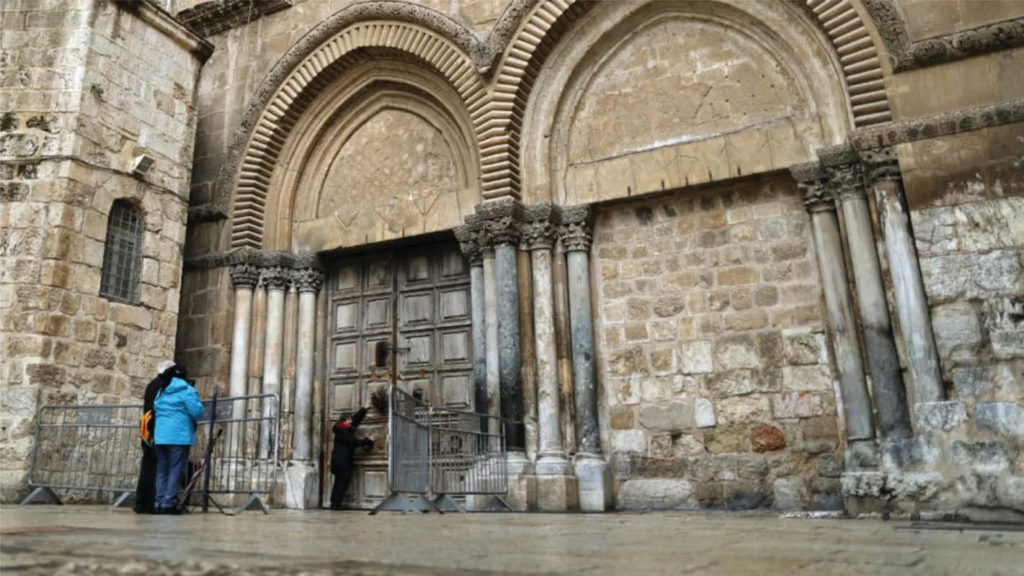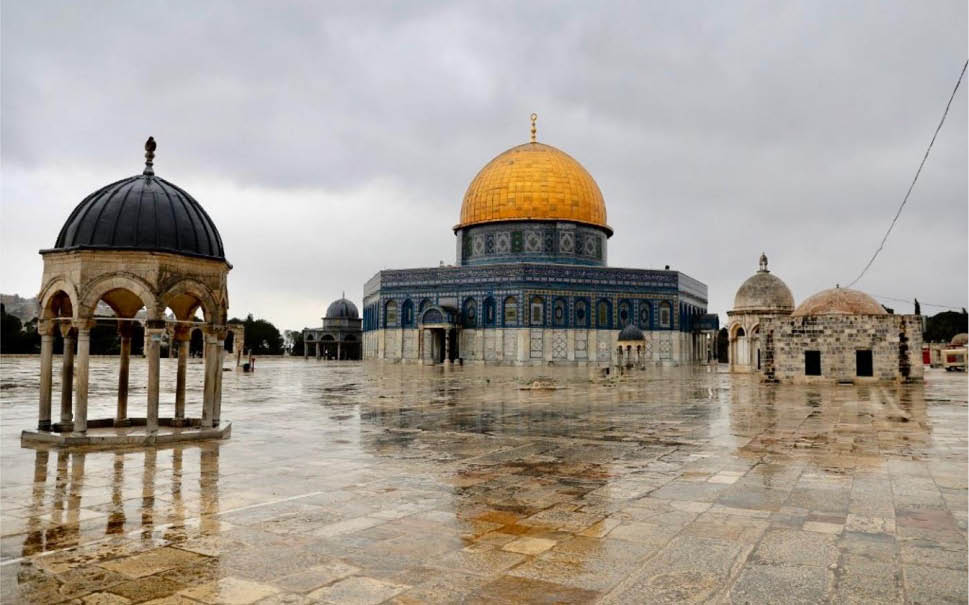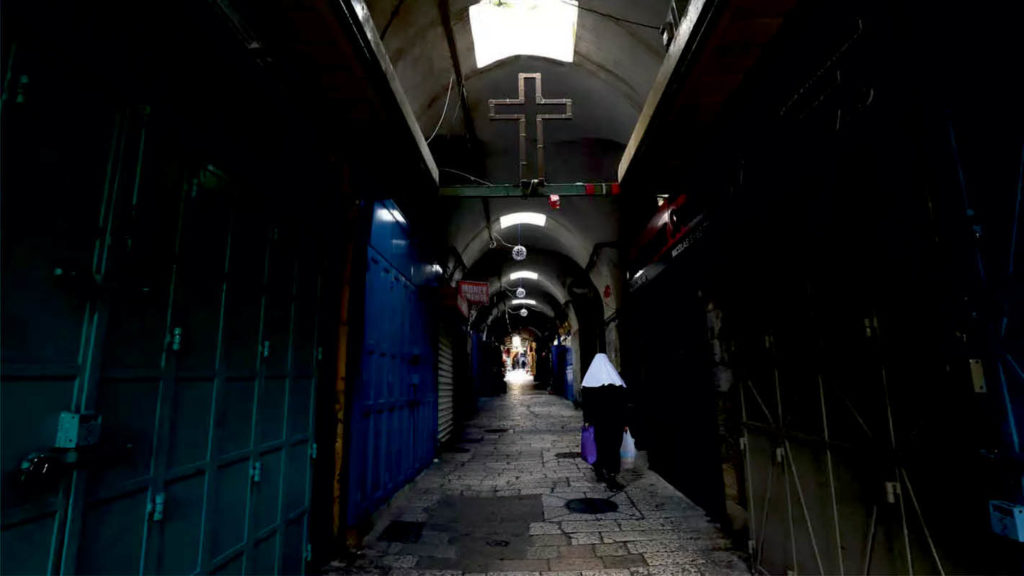The stagnating effect of the coronavirus reached the Holy City at a time when it was preparing for its peak season, the Easter holidays. Tourism in Al-Quds essentially completely stopped upon the Israeli government’s decision to block the entry of a number of nationalities into the country and require 14 days of home quarantine for all others (at the time this article was written). The issue seems to be increasingly complicated as the entire world struggles to control this virus.

The coronavirus pandemic is costing the Holy City dearly. Its detrimental effect must be added to a number of direct and cumulative losses and calamities that Jerusalem has had to deal with in the past, including the first and second Gulf wars, Sharon’s visit to the Noble Sanctuary that sparked the second Intifada, and the invasions of Gaza, particularly those that took place between 2010 and 2014, all of which discouraged tourism from abroad, not to forget the cumulative effect of the Israeli wall and the associated policies that have gradually deprived the city of its direly needed domestic demand as Palestinians were only allowed into the city with special, not-easy-to-get permits. During the past 30 years or so, Al-Quds has lost half of its hotels and about 30 percent of its shops in the Old City. It has lost its role as the real central city in Palestine, and it has lost its center to West Jerusalem. For example, if one looks online for a hotel in the “center of Jerusalem,” no Palestinian hotel will appear, although the majority of Palestinian hotels are in or around the Old City, which constituted the historic center of the city for millennia.
Unfortunately, Al-Quds has also witnessed a decrease in the number of its cultural events and a diminution of their weight and influence. In addition, its educational sector is also undergoing a transformation as the Israeli authorities are tightening their grip on school curricula and programs. The Israeli strategies in this respect are incremental, but their long-term goal is the annexation and Israelization of the education system, as has already been done with labor laws, health services, transportation, and building licenses, just to name a few.
The question then is how to save Al-Quds and how to prevent any further closures of its businesses and institutions. We must shed light on the threat posed by the ongoing marginalization and transformation of the city into a mere neighborhood attached to West Jerusalem, as has been the case with Jaffa, which has been annexed totally by Tel Aviv.
As the world faces the coronavirus pandemic, Al-Quds has to worry also about the next phase and its ability to spring back without losing any of its institutions. It is hoped that it will be able to do so with a much more resilient strategy that delves into its available and potential resources and capacities. Such a strategy should incorporate a much more international dynamic and competitive presence, such as becoming a global design hub, an education minaret, or anything else that invests in Al-Quds’s core value as a diverse and historically multicultural metropolis. To clarify, the tourism sector will continue to be the city’s main economic driver, however, investing in parallel sectors that possess various dynamics and links should, in theory, contribute to its resilience and value as a Palestinian city.

The tourism sector should be built on distinction and differentiation. For years, the Palestinian tourism industry in Al-Quds has depended almost entirely on Christian and Islamic pilgrimage. The former has been very competitively absorbed by Bethlehem, whereas the latter has grown intermittently, starting in the early 2000s. When the city needed it most, Islamic pilgrimage to Al-Quds saved many of its hotel establishments as well as its commercial sector from the spiral collapse it was facing as a result of the direct and cumulative losses it was enduring. Very few efforts and investments have been made to develop Al-Quds’ tourism sector, and very little has been done to promote its competitive advantage and ability to offer a unique and diverse experience beyond pilgrimage. Palestinians sell the same product and often the same offer as the Israelis. Tourism and pilgrimage packages to the Holy Land are generally designed abroad by international demand and the international tour operator. This has put Palestinian tourism at a disadvantage. Price rather than uniqueness has become the element of competitiveness. Since 2017, demand has risen quite substantially, and most hotels started to experience a sense of recovery and some leverage to pay off their debts and their various dues – until the coronavirus pandemic hit the city so unexpectedly.
Even though tourism was on the rise, complaints from the commercial sector in the city continued regarding a corresponding supply to the demand of their products. Tourist groups were overwhelming the streets and alleys of the Old City, cramming its various markets and souqs, yet they seldom bought anything from the shops. In addition, very few investments were made to protect and promote the local handcrafts sector. In fact, most of the artisan products in Al-Quds have been replaced by Chinese, Turkish, and other imported products and souvenirs. The reasons behind this are inherent in the prevailing type of tourism travel, namely, group business, also known as mass tourism, and the way it is orchestrated. In order for small and medium-size establishments, whether they are shops, restaurants, or hotels, to benefit from tourism, a different, or rather a parallel strategy needs to be developed. This strategy should seek various types of market segments, including domestic travel, and individual, family, and small-group business. This would allow more people to roam the streets of the Old City and the surrounding neighborhoods with greater potential to shop freely.
Micro destinations can serve as a medium to promote a uniquely Palestinian tourism experience. These would include locations and events to create interactive spaces and win-win situations among tourists and local residents.
In order for this to happen, however, a number of modifications and new investments need to take place to produce a genuine Palestinian tourism experience with programs, sites to visit, and events to attend. Diversity must be promoted, and the vast number of historical locations that depict multicultural neighborhoods, old Sufi schools, women’s architecture, cultural centers, museums, youth clubs, and other venues should be integrated. Some of these are in dire shape, yet they have been inhabited by Palestinian families for decades as a result of people’s relocation from other cities or from other countries, on one hand, and as a result of the various hardships that the city has faced, forcing people to cluster into available lodgings and refuges, on the other. Hence, any strategy to integrate these places into forthcoming tourism offers should stipulate a transfer of ownership of these micro destinations to the community of families that live within them in order to create a unique win-win situation.
The concept of micro-destinations is not foreign to the city. In the past, markets have specialized in certain products such as meat, spice, clothing, straw, sesame oil, and clay pots to attract shoppers and create experiences. What has changed is not the concept of specialization but rather the demand for these products and the way they need to be presented to respond to contemporary appeal. If organized and managed properly, certain streets that include religious, youth, academic, or cultural institutions that possess beautiful and hidden secrets would generate attractive added value and spaces for events and exhibitions. One such street is known as the Khanqa street that connects Souq Khan Ez-Zeit and Christian Quarter Street. Along this street, one finds the eighth Station of the Cross, the Greek Orthodox monastery, the Khanqa Salahiyyeh compound, the Arab Catholic Club, the Franciscan Monastery, and the Frères de La Salle School, among other attractions. These magnificent spaces are a thrill to explore and visit. Consolidating a package that includes all of them spiced with events, exhibitions, bazaars, and other experiences will create the core of an attractive micro-destination inside the Old City that is unique to Palestinians and not very easy for the competition to copy. Spaces in youth clubs, schools, and other community organizations offer a lot of opportunity to advance partnership between these organizations and private investors, hence creating another type of micro-destination. Such investments can provide the city with exciting and interactive spaces to add to the competitiveness and identity of a local Palestinian package.

Other additions to a developmental tourism package are interpretation centers. By definition, these are interactive cultural-heritage exhibition centers that explain the core value of a certain destination or area. Their ultimate purpose is to foster the protection of local cultural heritage and specific identities. The Indian, Moroccan, African, Coptic, Assyrian, and Armenian corners or neighborhoods all deserve to have an interpretation center to help shed light on their stories and uniqueness. Similarly, other community centers, museums, and micro-destinations, as described earlier, would add a lot of value to any visitor experience if such interpretive exhibits were added.
Interpretation centers can explain and promote the unique cultural heritage and specific identities of the various communities that make up the social fabric of Al-Quds, the Holy City.
In conclusion, the above are examples and elements of strategies to invest in and advance the local Palestinian identity of the city. This should be a sustainable effort. Indeed, there are and will continue to be major threats, direct losses, epidemics, wars, deprivation, and fragmentation as well as various challenges of seasonality, perceptions, and differentiation to deal with. Long-term decisions in such cases must be considered since, generally speaking, bad times do not last forever. Such times might even provide an opportunity to think of new packages and initiatives on one hand and a solid, strategic crisis-management plan on the other. The marketing strategy to maintain is one that targets smaller and less price-sensitive segments that are more responsive to various revenue streams in order to improve the tourism sector’s bottom line. It is imperative to deal with tourism not only as an industry but also as a platform for Palestinian culture and civilization. Ultimately, investing in identity remains a prerequisite to maintaining and advancing the urban feel and capacity of such a great and diverse city as Al-Quds.


